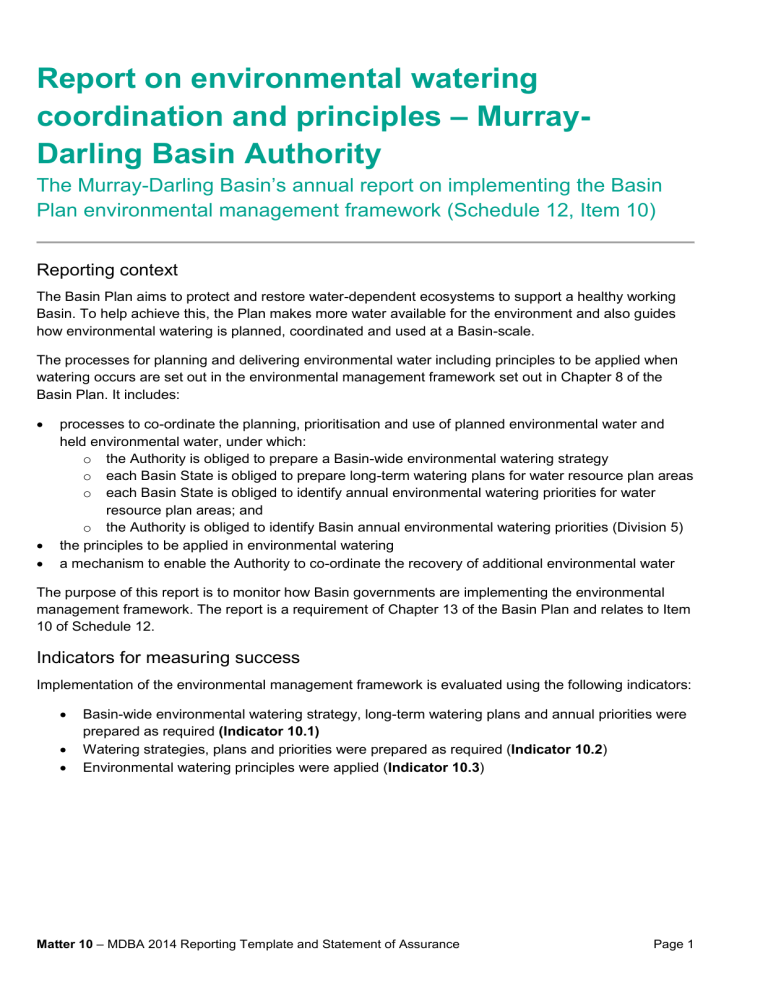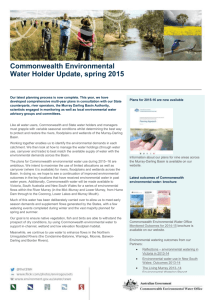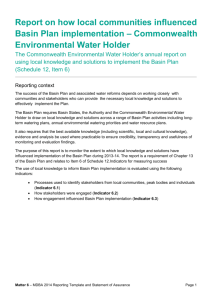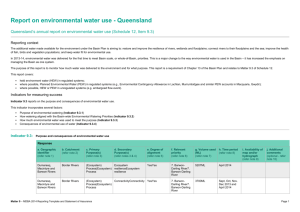DOCX - Murray-Darling Basin Authority

Report on environmental watering coordination and principles – Murray-
Darling Basin Authority
The MurrayDarling Basin’s annual report on implementing the Basin
Plan environmental management framework (Schedule 12, Item 10)
Reporting context
The Basin Plan aims to protect and restore water-dependent ecosystems to support a healthy working
Basin. To help achieve this, the Plan makes more water available for the environment and also guides how environmental watering is planned, coordinated and used at a Basin-scale.
The processes for planning and delivering environmental water including principles to be applied when watering occurs are set out in the environmental management framework set out in Chapter 8 of the
Basin Plan. It includes:
processes to co-ordinate the planning, prioritisation and use of planned environmental water and held environmental water, under which: o the Authority is obliged to prepare a Basin-wide environmental watering strategy o each Basin State is obliged to prepare long-term watering plans for water resource plan areas o each Basin State is obliged to identify annual environmental watering priorities for water resource plan areas; and o the Authority is obliged to identify Basin annual environmental watering priorities (Division 5)
the principles to be applied in environmental watering
a mechanism to enable the Authority to co-ordinate the recovery of additional environmental water
The purpose of this report is to monitor how Basin governments are implementing the environmental management framework. The report is a requirement of Chapter 13 of the Basin Plan and relates to Item
10 of Schedule 12.
Indicators for measuring success
Implementation of the environmental management framework is evaluated using the following indicators:
Basin-wide environmental watering strategy, long-term watering plans and annual priorities were prepared as required (Indicator 10.1)
Watering strategies, plans and priorities were prepared as required ( Indicator 10.2
)
Environmental watering principles were applied ( Indicator 10.3
)
Matter 10 ‒ MDBA 2014 Reporting Template and Statement of Assurance Page 1
Indicator 10.1:
Basin-wide environmental watering strategy, long-term watering plans and annual priorities were prepared, with the required content, published, reviewed and updated as obligated under Part 4 of Chapter 8, Divisions 2-5
Response
MDBA developed the first Basin Annual Environmental Watering Priorities and published them in June 2013. The priorities were for the 2013-14 water year.
This was the first time Basin priorities were used to guide environmental watering at a Basin scale. The priorities were reviewed and revised as part of the work to develop the 2014-15 priorities, which were subsequently published at the end of June 2014,
MDBA also developed the draft Basin-wide Environmental Watering Strategy for public feedback. The strategy was published in November 2014.
Indicator 10.2: Watering strategies, plans and priorities are prepared consistently with Part 4 of
Chapter 8, in relation to coordinating, consulting and cooperating with other
Reporters and the matters to which regard must be had (Chapter 8, Part 4)
Indicator 10.2.1. Description of how met responsibilities in Ch 8 Part 4
Response
Both the strategy and the priorities were prepared in consultation with other
Basin governments, and with input from a range of experts and stakeholders, including local communities, as required by the Basin Plan (see MDBA’s report under Item 6 for more details).
The Basin annual environmental watering priorities were prepared consistently with requirements of Chapter 8. For example, the ten Priorities were determined using the principles and method set out in Division 6, and considered the condition of environmental assets and ecosystem functions, consistency with the objectives of the environmental watering plan, likely effectiveness and risks.
As a result, the priorities identified had Basin-scale significance during that water accounting period, sought management outcomes relevant to the Resource
Availability Scenario, and required complex arrangements, such as the involvement of multiple parties and the achievement of multiple benefits.
The Authority initiated consultation with the Basin states, CEWH and the Basin community by publishing an Outlook in March 2014. This Outlook was the first step in developing the 2014-15 Basin priorities and was useful in commencing a dialogue between holders and managers of environmental water across the
Basin. This was followed up with more extensive consultation.
The Basin-wide environmental watering strategy was still in development for
2013/14, nevertheless, significant progress had been made in complying with the requisite purpose, content and consultation requirements. This included: explaining the context in which the priorities will be set; helping to coordinate the management of environmental water by setting long-term outcomes and clarifying the roles and responsibilities of the MDBA, CEWH and Basin states; and identifying particular environmental assets and functions and their environmental watering requirements. Consultation had also commenced with
Basin states and the CEWH.
Matter 10 ‒ MDBA 2014 Reporting Template and Statement of Assurance Page 2
Indicator 10.3:
Environmental watering principles are applied as set out in Division 6 of Chapter 8,
Part 4
Indicator 10.3.1. Description of how principles applied
Response
Chapter 8, Div 6 outlines the principles to be applied in environmental watering.
MDBA reported on how it applied these principles across a range of its responsibilities: for its water management especially in the River Murray; and The Living Murray Program (MDBA reported on behalf of partner governments)
Principle Description
Principle 1: Basin annual environmental watering to be undertaken having regard to the Basin annual environmental watering priorities
TLM’s delivery of environmental water (in coordination with the other environmental water holders) provided flows to four Basin Plan priorities
– lower Goulburn, mid-Murray, lower Murray, and
Lower Lakes, Coorong and Murray Mouth. TLM water has to be delivered for the benefit of TLM icon sites and therefore did not provide flows to all
Basin Plan priorities.
Principle 2: Consistency with the objectives for water-dependent ecosystems
Principle 3: Maximising environmental benefits
TLM water was delivered consistent with the objectives for water-dependent ecosystems. For example, TLM contributed to a large watering action that provided flows to the Lower Lakes,
Coorong and Murray Mouth. This helped maintain an open Murray Mouth, allowed continuous water exchange with the Coorong, lowered salinity levels in Lake Alexandrina and provided appropriate conditions for the flowering and fruiting of Ruppia into the early summer.
TLM watering proposals that maximise outcomes at a system level are scored higher when assessing where to provide water and how much to deliver
In 2013 –14, environmental water was used to supplement natural flows in the river, providing water to the six icon sites. A total of 327 gigalitres of TLM environmental water was delivered in the
River Murray system in coordination with other environmental water holders.
The environmental watering actions undertaken in
2013 –14 had considerable ecological benefits, improving the health of many parts of the river system. They also provided water to allow the operational testing of recently completed water management structures at Hattah Lakes and
Mulcra Island. Testing confirmed the design and operation of the structures, ensuring the efficient
Matter 10 ‒ MDBA 2014 Reporting Template and Statement of Assurance Page 3
Principle
Principle 4: Risks
Description delivery of water to these icon sites in the longer term.
Watering actions were coordinated with actions by other environmental water holders to deliver multiple ecological benefits for the whole system.
TLM water returning from Barmah –Millewa Forest and the Goulburn was used to support the achievement of ecological outcomes at the Lower
Lakes, Coorong and Murray Mouth, as well as providing benefits to the River Murray Channel along the way.
Risks associated with delivering TLM environmental water were managed throughout the year. Measures included :
Water proposals submitted by jurisdictions identified potential risks associated with water actions and mitigation measures. These were considered in the prioritisation of proposals
(Environmental Risks associated with the watering) and the development of the TLM annual environmental watering priorities
(AEWP).
Local and system-scale risks and mitigation measures were considered as part of the Risk
Management framework in the TLM AEWP.
Where available, modelling was used to help identify and mitigate potential risks such as poor water quality and third-party impacts for TLM watering actions.
At times changes were made to delivery flow patterns, timing and volume to avoid potential risks.
Real time data was provided to TLM during environmental water delivery through OAG’s or directly through River Operations. This data was used to monitor risk and inform the response.
Principle 5: Cost of environmental watering
Principle 6: Apply the precautionary principle
The cost of environmental watering was considered in the process of prioritising TLM watering as the
‘Amount of benefit for volume of water ‘.
TLM undertook a large watering action to try to halt the declining health of Moira grass communities.
This watering action required large volumes of water that would be cost and resource prohibitive under normal regulated conditions. However the occurrence of large natural overbank flows presented an opportunity for TLM and other environmental water holders to deliver additional water to extend the duration of the high flows.
TLM activities sought to maximise environmental outcomes while having regard to the Basin Plan.
Matter 10 ‒ MDBA 2014 Reporting Template and Statement of Assurance Page 4
Principle
Principle 7: Working effectively with local communities
Description
Watering proposals were informed by substantiated data, including scientific, expert opinion and best available on-ground information.
At times TLM may undertake watering actions that may not have full scientific certainty. Under these circumstances the positive ecological benefits derived from environmental water delivery are considered against the potential risks associated with the watering action and the risks of not watering. Mitigation strategies are used where possible to lower any associated risks with watering and risks are carefully monitored during water delivery.
Icon site managers enable local community involvement on behalf of TLM. This includes consultation before, during and after watering events. Icon site managers also coordinate community reference groups that provide advice and help to disseminate information.
Principle 8: Adaptive management
Adaptive management principles were applied throughout the planning and delivery of TLM environmental water in 2013-14:
Monitoring results were used to develop watering proposals
An annual review identified areas for improvement.in planning and delivering environmental water and changes were implemented as part of the 2013-14 program
Real-time decision making allowed TLM to respond to changing river and climatic conditions. These were informed through the
Operational Advisory Groups (OAGs)
MDBA’s River Operations reported on taking an adaptive management approach in managing water:
Adaptive management is built into river operations through the Environmental
Guidelines framework, which enables river operations to be changed to improve environmental outcomes. Work in 2013-14 focused on improving flow variability in the Mitta
Mitta River and the lower Darling River. In the
Mitta Mitta the movement of Murray Cod is being tracked to determine relationships to water level, flow and thermal conditions, to identify opportunities to improve the existing
Environmental Guidelines for flow variability in the Mitta Mitta River . In the lower Darling River a variable bulk release was made for the first time. The hydrograph was designed to trigger
Golden Perch spawning. Initial results indicate this was achieved
Matter 10 ‒ MDBA 2014 Reporting Template and Statement of Assurance Page 5
Principle Description
The Basin Officials Committee (BOC) has set
Objectives and Outcomes for River Operations in the River Murray System. Performance against the objectives and outcomes is assessed annually by the Independent Review of River Operations Group (IRORG). IRORG’s recommendations lead to river operations being revised. In 2014 IRORG ’s membership was extended to include expertise in environmental water delivery, which will further support improving river operations to achieve multiple objectives.
Trials commenced to use alternative minimum rates of rise and fall for Hume Dam, releases to reduce unseasonal flooding of the Barmah-
Millewa Forest. If the trials are successful
Specific Objective and Outcome 2.2 will be amended
MDBA assisted NSW with a trial to manipulate water levels at locks 8 and 9 to improve variability and riparian vegetation. This may lead to new Specific Objectives and Outcomes and Environmental Guidelines
BOC approved amendments to Specific
Objective and Outcome 1.4 to improve the implementation of variable flow releases in the
Mitta Mitta River
Principle 9: Relevant international agreements
TLM environmental watering actions considered international agreements such as Ramsar. For example, the watering undertaken at Barmah focused on the Moira grass plains which are part of the Ramsar ecological description for Barmah.
Principle 10: Other management and operational practices
River operational practices were reviewed by the
Independent River Operations Review Group
(IRORG). Recommendations were considered in planning and delivering environmental water, in close consultation with MDBA River Operations.
Principle 11: Management of water for consumptive use
TLM’s regular consultation with MDBA River
Operations ensured that the management of water for consumptive use was considered in the delivery of TLM environmental water.
River Operations managed water for consumptive use to support environmental and cultural outcomes.
MDBA River Operations:
managed water orders and rain events to avoid unwanted flooding of the Barmah-Millewa
Forest
water quality in the Mitta Mitta River was improved by making variable flow releases from
Matter 10 ‒ MDBA 2014 Reporting Template and Statement of Assurance Page 6
Principle
Case study (if available)
Description
Dartmouth Dam and by passing spring inflows to the dam close to the natural pattern
helped to protect cultural heritage and support the establishment of riparian vegetation at Lake
Victoria through the Lake Victoria Operating
Strategy
supported the CEWH to maintain instream connectivity by deviating from the standard practice of diverting flows through Lake Victoria and allowing environmental water to stay within the main channel of the River Murray.
Supported aquatic vegetation, water quality and fish passage at the Lower Lakes by meeting lake water level targets.
Matter 10 ‒ MDBA 2014 Reporting Template and Statement of Assurance Page 7



